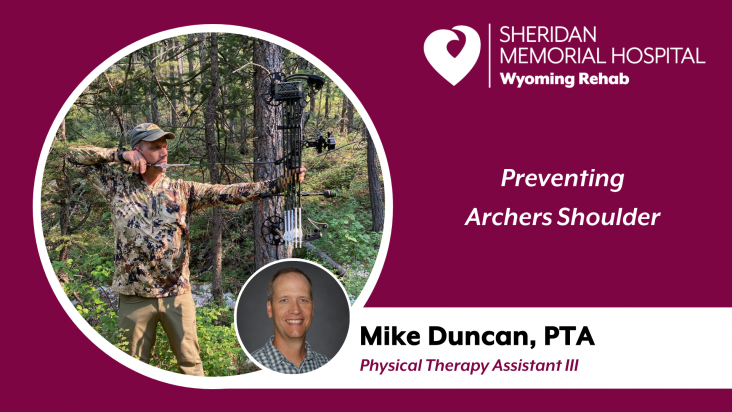By Mike Duncan, Physical Therapy Assistant III at Sheridan Memorial Hospital’s Wyoming Rehab
The fall season is rapidly approaching and for many Wyoming residents, that means hunting season. Hunting with archery equipment or bow hunting thrills many Wyoming hunters.
Archery is truly an amazing sport. Saxton Pope summarized it perfectly when he said this, “Here we have a weapon of beauty and romance. He who shoots with a bow, puts his life’s energy into it. The force behind the flying shaft must be placed there by the archer. At the moment of greatest strain he must draw every sinew to the utmost; his hand must be steady; his nerves under absolute control; his eye keen and clear. In the hunt he pits his well-trained skill against the instinctive cunning of his quarry. By the most adroit cleverness, he must approach within striking distance, and when he speeds his low whispering shaft and strikes his game, he has won by the strength of arm and nerve. It is a noble sport.”
If you think about the basic actions of shooting a bow – pull back with the fingers or wrist and arm, rotate through the shoulder, hold, and release – it probably becomes clear why upper extremity conditions are some of the most commonly diagnosed injuries among bow hunters. The drawing back of the strings demands a lot from the smaller muscles of the rotator cuff, forearm, wrist, and fingers. Plus, repetitive target practice to improve aim, timing, and other hunting skills can easily result in chronic pain or injury from overuse, referred to as Archers shoulder.
Injuries to the rotator cuff are archery’s most common problem. The rotator cuff is a complex system of muscles and tendons in your upper arm that is used to draw a bow and to raise and rotate your arm. Rotator cuff injuries include tendinitis, bursitis, and, in severe cases, a rotator cuff tear. Tendonitis is a condition that results from the rotator cuff tendons becoming irritated or damaged. Bursitis involves the fluid-filled “pillow” that acts as a cushion between the rotator cuff tendon and shoulder blade, which may become irritated or inflamed. A torn rotator cuff tear may put you out for the season but is not always easy to diagnose. Symptoms include having trouble lifting, raising your arm, pain when moving, shoulder weakness, or a clicking sound in your shoulder when moving it. If you have any of these symptoms, stop shooting and seek competent medical advice. Through skilled rehabilitation, most archers recover and resume shooting upon completing physical therapy.
Specific exercises and stretches from a qualified professional at Wyoming Rehab will alleviate and can prevent the common conditions associated with Archers shoulder and return you to the range or to the hunt. Call us today to set up a free screening for non-emergent physical impairments or injuries – 307.674.1632.
Learn more about Wyoming Rehab services by following the link sheridanhospital.org/medical-services/rehabilitation-services/

